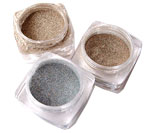Dear Umbra,
What is the half-life of glitter and what is the environmental impact of said glitter on the ground?
Planet Diva
Austin, Texas
Dearest Planet Diva,
Everyone should know the truth: Write me a question about glitter and I will answer it right away. Glitter floats to the top of thousands of questions and shimmers there, distracting me from analysis of household air samples.
Glitter. Glitter is to plastic, glass, and aluminum as sand is to rocks. Normal, everyday materials, colored and cut into tiny shapes and sizes for cosmetic, technologic, and craft purposes — that is our magical glitter.

Pots o’ gold (glitter).
Knowing that glitter is just small bits of plastic, glass, and aluminum should help you evaluate its environmental impact. Leaving glitter on the ground is littering (or perhaps a whole new category of environmental offense: g-littering) and if you don’t want to feel like a low-level pollutocrat, you should reduce your glitter droppings. I imagine that glass and aluminum glitter could lacerate certain tiny soil-dwelling invertebrates, and glitter on the pavement will eventually get into sewer systems and end up in bodies of water. Other potential negative side effects of large-scale festive glitter tossing include inhalation hazards. Small glitter would count as particulate matter and may aggravate asthma and other respiratory ailments among participating or bystanding festivity goers.
The term “half-life” is mainly used to characterize the longevity of radioisotopes, drugs, and potentially noxious chemicals. But don’t let that discourage you — the scientific community may be clamoring for a study of glitter’s half-life, and you may be the person to do it. Until then, we must assume that glitter has the longevity of other plastic, glass, and aluminum objects, albeit sparklier by half.
Twinkly,
Umbra

